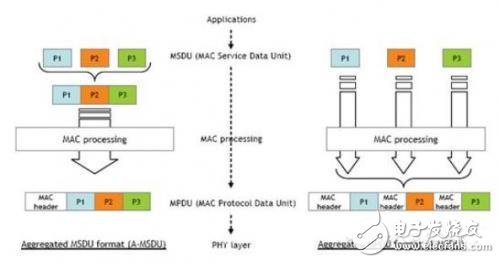Technical white must read: What are the key technical points of 802.11n?
With up to 600 Mbps, the 802.11n standard is a next-generation wireless networking technology that delivers the speed, range and reliability needed to support the most bandwidth-sensitive applications. 802.11n combines multiple technologies, including SpaTIal MulTIplexing MIMO (MulTI-In, MulTI-Out) (Spatial Multiplex Multiple Input Multiple Output), Multiple Receive Multiple Antenna (MTMRA) technology, 20MHz and 40MHz channels and dual bands (2.4 GHz and 5 GHz) technologies to create very high rates. The 802.11n working mode includes two working frequency bands of 2.4 GHz and 5.8 GHz, which ensures compatibility with the previous 802.11a/b/g standard and greatly protects the user's investment.
First, the technical core of 802.11n
802.11n focuses on high-throughput research, increasing the WLAN transmission rate from 54Mbps for 802.11a and 802.11g to over 108Mbps, with a maximum rate of 300Mbps or even 600Mbps.
Such a high rate of course has technical support, and OFDM technology, MIMO (multiple input and multiple output) technology is the key.
OFDM technology is a type of MCM (Multi-Carrier Modulation) that was once adopted in the 802.11g standard. The core idea is to divide the channel into a number of narrowband modulation and transmission orthogonal subchannels, and make the signal bandwidth on each subchannel smaller than the relevant bandwidth of the channel, to reduce the mutual interference between the carriers, and improve the spectrum utilization. Technology. OFDM also enables uplink and downlink asymmetric transmissions by using different numbers of subchannels. However, OFDM technology is susceptible to frequency deviation and has a high peak-to-average power ratio (PAR). However, space-time coding, diversity, interference suppression, and smart antenna technology can be used to maximize the reliability of the physical layer.
MIMO (Multiple Input Multiple Output) technology is a major breakthrough in smart antenna technology in the field of wireless communications, which can double the capacity and spectrum utilization of communication systems without increasing bandwidth.
A MIMO system employs multiple antennas (or array antennas) and multiple channels at both the transmitting end and the receiving end. The transport stream S(k) is space-time coded to form N information substreams Ci(k), i=1, . . . , N. The N substreams are transmitted by N antennas, and are received by M after the spatial channel. Antenna reception. Multi-antenna receivers can separate and decode these data substreams using advanced space-time coding processing. MIMO systems can create multiple parallel spatial channels and solve the problem of bandwidth sharing. The number of 802.11n antennas can support up to 3*3, which is a threefold increase over 802.11g.
Combining MIMO with OFDM technology, MIMO OFDM technology is generated, which achieves spatial diversity by using array antennas in OFDM transmission systems, improves signal quality, and increases multipath tolerance, enabling efficient transmission rates of wireless networks. There is a qualitative improvement.
In order to improve the throughput of the entire network, 802.11n also optimizes the single MAC layer protocol of the 802.11 standard, changes the data frame structure, increases the proportion of the net load, and reduces the number of bytes occupied by the management error detection. Increased network throughput. On the antenna, the application of smart antenna technology also solves the transmission coverage problem of 802.11n. The antenna array system consisting of multiple sets of independent antennas dynamically adjusts the direction of the beam. 802.11n ensures that users receive stable signals and reduce interference from other noise signals, so that the transmission distance of the wireless network can be increased to several kilometers. Sexually enhanced.
Second, the key points of 802.11n technology
1, the key point: channel binding
Schematic:

In the traditional 802.11 standard, the air interface operates at a bandwidth of 20 MHz. The 802.11n technology doubles the transmission rate by bundling two adjacent 20 MHz channels into 40 MHz. In actual work, two adjacent 20MHz channels are used for binding, one for the primary bandwidth and one for the secondary bandwidth. When transmitting and receiving data, it can work with either 40MHz bandwidth or a single 20MHz bandwidth. At the same time, in order to avoid mutual interference, a small portion of bandwidth is reserved between every 20 MHz channel. When the channel bonding technology works at 40 MHz bandwidth, this reserved bandwidth can also be used for communication, further improving throughput. the amount.
It should be noted that there are limited resources in 2.4GHz (less channel bandwidth) and more interference (more clients using 802.11b/g), so it is recommended not to use 40MHz mode at 2.4GHz and 40MHz mode at 5 GHz. Reasonable choice.
2. Key points: MIMO
2.1 Beamforming Technology
Taking Transmit beamforming as an example, the technique is applied to an environment where there is only one antenna at the receiving end and there is no obstacle. If Beamforming technology is not used, the phase received at the receiving end may be out of phase.

Transmit Beanforming(Destructive Interference)
After adopting the Beamforming technology, the receiving end can receive the positive phase phase to maximize the signal, as shown in the figure below, and achieve the purpose of improving the SNR at the receiving end.

Transmit Beanforming(Constructive Interference)
However, Transmit beamforming can only be used when there is only one receiver, and the application is limited.
2.2 Spatial Diversity
Indoors, there are many obstacles, and the signal cannot always be transmitted to the receiving end in the shortest straight line. At this time, Multipath (multipath interference) is generated. Multipath interference is the result of delay due to transmission of different paths. It can impair signal transmission and generate gaps or holes within the RF coverage. Surfaces such as lakes and metal-like doors/blinds can cause serious multipath interference.
For MIMO systems, multipath effects can be exploited as a positive factor.
The MIMO system uses multiple antennas (or array antennas) and multiple channels at both the transmitting end and the receiving end (as shown in the red circle, both the transmitting end and the receiving end can have multiple antennas), and the transmission information stream S(k) passes through the air. The time code forms N information substreams Ci(k), i=1, . . . , N, and the N substreams are transmitted by N antennas, and are received by M receiving antennas after the spatial channel. Multi-antenna receivers use advanced space-time coding to separate and decode these data substreams for optimal processing.
MIMO can be defined using the number of received and transmitted, for example: 2 × 1: indicates two transmissions and one reception, the effect is equivalent to Transmit beamforming, as shown in the following figure. From 2 × 1 to 2 × 2 to 3 × 2, the SNR gradually increases, and 3 × 3 can maximize the SNR.

3. Key points: MAC enhancement (A-MSDU A-MPDU)
The 802.11 MAC layer protocol consumes considerable efficiency for link maintenance. For example, adding PLCP Preamble, PLCP Header, and MAC header before data, and the backoff mechanism introduced to resolve conflicts greatly reduces system throughput. 802.11n introduces frame aggregation technology to improve the efficiency of the MAC layer. The message aggregation technology includes aggregation for MSDU and aggregation of MPDUs. With the A-MPDU technology, multiple MPDUs are aggregated together, and only one channel is preempted, which reduces the probability of collision due to the contention channel and improves channel utilization. A-MSDU is an aggregation of MSDU packets with the same DA and SA into a larger payload, reducing physical and MAC layer overhead and improving link efficiency.
A-MSDU
The commonality between the two aggregations and the A-MPDU is that the load is reduced and only the frames of the same QoS level can be aggregated. However, delays may occur due to waiting for packets that need to be aggregated. In addition, Block Acknowledgement is only used for A-MPDUs.

4, the key point: Short GI
When the RF chip transmits data using OFDM modulation, the entire frame is divided into different data blocks for transmission. For the reliability of data transmission, there is a GI (Guard Interval) between the data blocks to ensure that the receiving side can Parse each data block correctly. The 800ns GI used by 802.11a/g provides a Short GI feature in 802.11n mode. Reduce the GI duration to 400ns, which can increase the data transfer rate by about 10%.
As shown in the figure, in a multipath environment, the previous data block has not been transmitted yet, and the latter data block may arrive first through different paths. A reasonable GI length can avoid mutual interference. If the GI duration is unreasonable, it will reduce the effective SNR of the link.

Usage scenario: Short GI is used in applications with less multipath conditions and better RF environment. When the multipath effect has a large impact, the Short GI function should be turned off.
5, the key point: Block Acknowledgement
To ensure the reliability of data transmission, the 802.11 protocol stipulates that every time a unicast data frame is received, it must respond to the ACK frame immediately. After receiving the A-MPDU, the receiving end of the A-MPDU needs to process each MPDU, so it is also necessary to send a response frame to each MPDU. The Block Acknowledgement mechanism completes the response to multiple MPDUs by using one ACK frame to reduce the number of ACK frames in this case.
6, the key point: Power Savings
When using 802.11n services, the power supply capacity problem is particularly prominent due to the use of multiple antennas. Therefore, the 802.11n protocol has been improved in saving power processing, using Spatial.
The main processing of the Multiplexing (SM) Power Save technology is that the STA has only one antenna in the working state, and the other antennas are in a dormant state, thereby achieving the purpose of saving power. SM Power Save defines two power management methods: Static SM Power Save and Dynamic SM Power Save.
Static SM Power Save
When the wireless user is in the static mode, only one antenna remains in the working state, and the remaining antennas are in a sleep state, which is equivalent to an ordinary 802.11a or 802.11b/g user. In this way, the power supply time of the power supply can be extended. When entering the sleep state, the wireless user will notify the uplink AP that it is in the static mode, and requires the AP to perform data transmission for the user also in a single-input single-slave (SISO) manner. Similarly, when the wireless user resumes normal working state, the AP is also notified to switch to the MIMO mode for data transmission.
Dynamic SM Power Save
The dynamic mode also keeps only one antenna in operation, but when the wireless user receives the data message, it can make other antennas quickly enter the working state. After the message is processed, it can restore the rest of the antenna to sleep. This notification mechanism is implemented through RTS and CTS. The AP will wake up the wireless user through the RTS, and the wireless user will respond to the CTS message to inform the AP that the antenna has been successfully restored to the working state.
Nickel Alkaline Battery,Solar Energy Battery,48V Nife Battery 200Ah ,Ni-Fe Battery 100~200Ah
Henan Xintaihang Power Source Co.,Ltd , https://www.taihangbattery.com